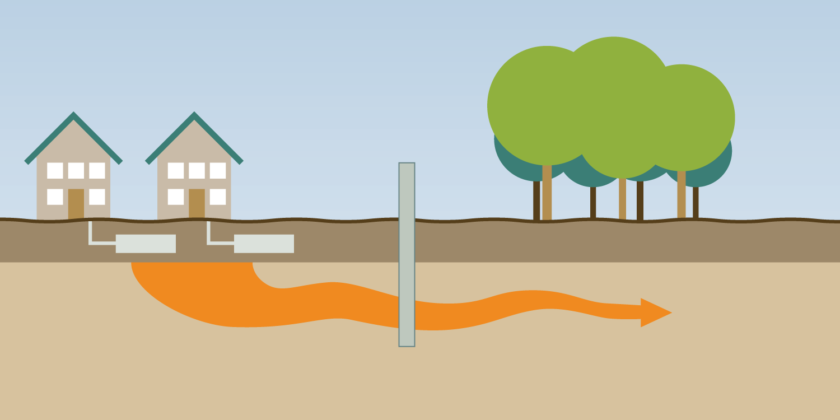Protecting & Restoring Long Island's Peconic Bays

A PRB is a permeable treatment zone placed in situ within an aquifer to intercept and treat contaminant plumes or plumes of elevated groundwater concentrations of nitrogen. The term “barrier” conveys that flow is impeded but the system is designed to be more permeable than the surrounding soil so that groundwater can easily flow through the system without significantly affecting hydrology (ITRC 2011). Trench PRBs are installed vertically to intercept groundwater in its path toward surface waters but also may be installed horizontally, to target water infiltration before it reaches groundwater (Beganskas et al. 2018). In situ applications rely on supplying an electron donor (carbon source) such as wood chips, similar to nitrogen-removing biofilters, to promote microbial degradation and conversion of dissolved nitrogen to nitrogen gas in an oxygen-free environment. PRB design, construction, and placement requires careful consideration of site hydrogeology, nitrogen speciation, dissolved oxygen dynamics, and site conditions to ensure the targeted groundwater plume is intercepted and the PRB dimensions provide adequate residence time for treatment (ITRC 2011). PRBs installed adjacent to impaired waterbodies, can help mitigate coastal eutrophication (Graffam et al. 2020). Regions with slow or dynamic groundwater flow, low dissolved oxygen conditions in groundwater, and/or nitrogen speciation dominated by ammonium and/or organic nitrogen, rather than nitrate, may be unsuitable for PRBs.
The installation of PRBs in New York State for nitrogen removal are currently not regulated unless they fall under a regulated site under the New York State Department of Environmental Conservation (NYSDEC) environmental remediation or U.S. Environmental Protection Agency (USEPA) superfund programs and thus may require extensive feasibility assessments, pilot-testing, and monitoring.
PRBs installation sites should have limited public utilities and vegetation and provide access for construction. PRBs generally require 20 feet of saturated aquifer thickness and a relatively level site (ITRC 2011). Detailed knowledge of gPRBs installation sites should have limited public utilities and vegetation and provide access for construction. PRBs generally require 20 feet of saturated aquifer thickness and a relatively level site (ITRC 2011). Detailed knowledge of groundwater hydrology at the site it critical as trench PRBs need to be aligned perpendicular to groundwater flow and placed in areas with high groundwater flow rate (Cape Cod Commission 2020). It is also important that the PRB does not significantly alter the hydraulic conductivity of the aquifer (ITRC 2011). In the past, placement near coastal waters have resulted in the production of hydrogen sulfide and redirection of flow due to tidal pumping, which resulted in inadequate treatment (Vallino and Foreman 2008). However, nitrogen removal was not negatively impacted at a PRB recently installed in a bulkhead in Bennet Cove in Shinnecock Bay (Graffam et al. 2020). Regions with slow or dynamic groundwater flow, low dissolved oxygen conditions in groundwater, and/or nitrogen speciation dominated by ammonium and/or organic nitrogen, rather than nitrate, may be unsuitable for PRBs. Aligning locations that have high nitrate and oxygen, high groundwater flow rates, and can be accessed for construction with heavy equipment for deep trenching can be challenging.
The following permits may be required for installation of PRBs depending on location:
Nitrogen removal of PRBs is highly dependent on residence time. For vertical trench PRBs residence time is determined by the groundwater velocity and corresponding width of the installation (AECOM 2016). The residence time of horizontal BMPs is dependent upon infiltration rates; high infiltration rates may inhibit denitrification by promoting oxic conditions (Beganskas et al. 2018). In addition, a dominance of nitrate as the primary nitrogen species is required. Some coastal groundwater has been found to have very high levels of nitrogen, but dominance of ammonium, for example, when septic plumes are nearby; standard PRBs can only remove nitrate from groundwater.
The influent source for PRBs is groundwater at a flow rate of ideally 0.5 – 2 feet per day. Lower and upper bound nitrogen removal estimates consider elevated groundwater concentrations of 5 and 20 milligrams per liter (mg/L), respectively. The range of removal efficiencies are based on those reported by the Cape Cod Commission (2020) for trench PRBs. Nitrogen removal rates are per linear foot of PRB.
PRB Nitrogen Effluent Concentrations, Nitrogen Reduction, and Annual Removal Rates
| Technology | Effluent Nitrogen Concentration (mg/L) | Nitrogen Reduction (%) | Annual Nitrogen Removal (lb/yr) |
|---|---|---|---|
| PRB | 3–5 | 70–75 | 2–8.2 |
Detailed costs associated with PRB design, construction, monitoring, and O&M were made available for full scale PRBs based on pilot studies conducted on Cape Cod (AECOM 2016) and form the basis for these estimates. Capital costs for a 3,500 linear foot PRB were estimated to be $2,940,000. Detailed costs for several PRBs installed in Suffolk County at Bennet Cove, Accabonac Harbor, Three Mile Harbor, and proposed for Lake Agawam, were not available but available line-item costs appear to fall within a similar range as the Cape Cod installations. Lower and upper bound O&M costs are based on rejuvenating the system every 7 and 3 years, respectively (AECOM 2016). Costs were annualized over 20 years with a 5% discount rate applied to capital costs and the annual average O&M cost with a 2% inflation rate applied. Costs are presented per linear foot of PRB.
Individual NRB Capital, O&M, Total Annualized Costs, and Costs per Pound of Nitrogen Removed
| BMP Type | Capital Cost per Linear Feet | Average Annual O&M Costs per Linear Feet | Annualized Total Cost Per Linear Feet | Cost per Pound N Removed |
|---|---|---|---|---|
| PRB | $840 | $67–$201 | $284–$419 | $35–$102 |
Sign up for News, Events and Information straight to your inbox.

Notifications